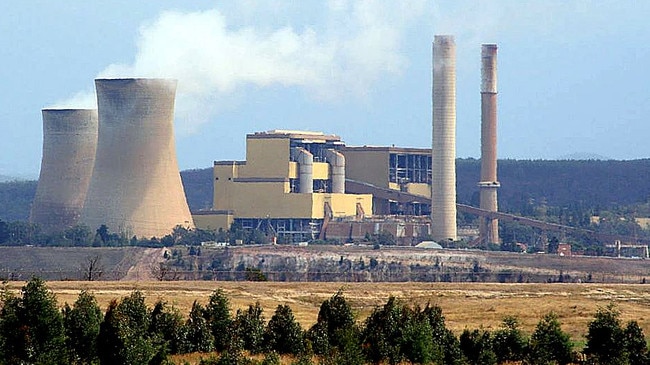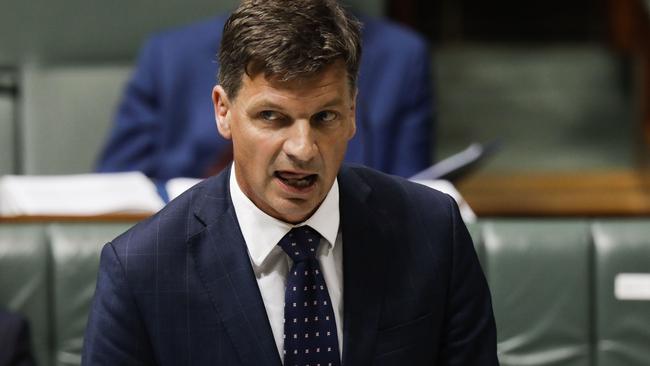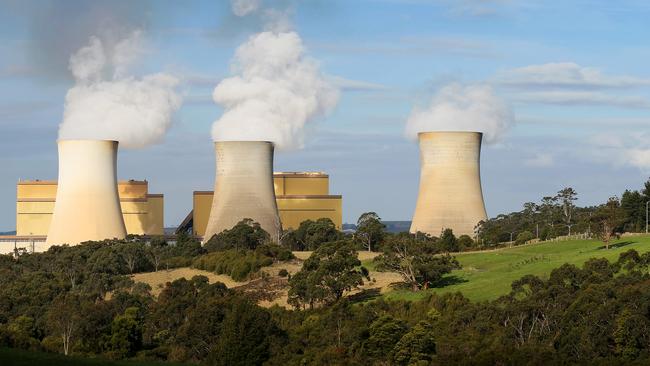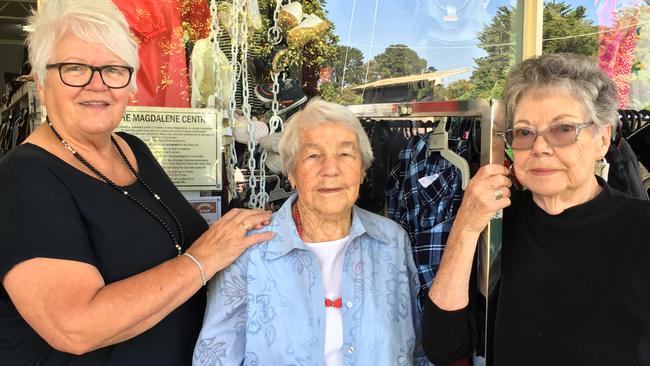Yallourn power station to close in 2028 — four years earlier than expected
The Latrobe Valley community has expressed its shock as locals stare down the end date for another power station in the region.
Victoria
Don't miss out on the headlines from Victoria. Followed categories will be added to My News.
Victoria’s Yallourn coal-fired power station will shut down four years earlier than expected in 2028.
The Herald Sun can reveal EnergyAustralia will announce on Wednesday morning that the closure date has been brought forward to the middle of 2028.
It is understood a transition package for workers will also be unveiled by the energy giant.
Yallourn, in the Latrobe Valley, provides 22 per cent of Victoria’s electricity.
It employs 500 workers although this can swell up to 1000 at critical times such as a power outage.
But its long-term future has been in doubt as the state government has moved towards introducing strict emissions reduction targets.
EnergyAustralia will tip $10 million into a transition package to retrain affected workers.
It will also build a new 350mw battery — larger than any operating in the world — which will employ 80 workers during the construction phase.
It will be up and running ahead of the Yallourn closure.

EnergyAustralia chief executive Catherine Tanna said while Wednesday’s announcement may have surprised some of the company’s workers, the context in which it was made would not.
“The world of energy is rapidly changing as we transition to cleaner forms,” she said.
“Supporting people, supporting the La Trobe Valley and locking in energy storage will ensure the smoothest transition possible.
“We are determined to show Australia that when it comes to the energy transition, it is possible to move from the old to the new in a way that does not leave people behind.”
Asked about the impact on power prices, Ms Westcott said it was “impossible” to say whether the closure of Yallourn would send them higher.
“That’s a question that is absolutely impossible to answer,” she said.
“What I can is that by entering into his agreement with the state of Victoria, and giving the clarity of a mid-2028 closure date of Yallourn, that we give the maximum amount of clarity for the whole market which should deliver more affordable prices for all customers.”
EnergyAustralia executive Liz Westcott said while coal-fired power stations have been the backbone of the nation’s energy system for decades, it was less required as renewables entered the system.

“The system is changing before our eyes and, with every passing day, we take a step forward to this clean future,” she said
Yallourn has come under mounting pressure as the state government has moved towards introducing strict emissions reduction targets and new solar and wind generation has eaten into its profitability.
That pressure has mounted during the COVID-19 pandemic as demand for power dropped.
The sudden exit of Hazelwood in 2017 sent shockwaves through the nation’s energy sector and prompted a spike in wholesale energy prices.
Ms Tanna said EnergyAustralia had struck a deal with the Victorian government under which it would be supported to operate Yallourn until 2028.
“Our belief is the system needs something like Yallourn out to 2028,” she said.
“There is as part of the agreement with the Victorian state government a safety net to ensure that’s what happens.”
Former Committee for Gippsland chief Mary Aldred welcomed EnergyAustralia providing seven years’ notice for the closure, compared to the snap shutdown of Hazelwood.
“The immediate task for government, business and the community is all hands on deck to secure a future for highly skilled, highly paid jobs in the Latrobe Valley,” she said.
CLOSURE A ‘KICK IN THE GUTS’
Shadow Minister for Energy and Renewables, Ryan Smith, said the closure would be a kick in the guts to the Latrobe Valley.
Mr Smith said the government also had no plan to transition out of coal, which risked more regular blackouts and higher prices, and would leave hundreds of locals out of work.
“Labor believes in policies that effectively shut down reliable coal-fired power supply but without a plan to transition to renewables,” he said.
“Labor’s lack of planning means will be more susceptible to blackouts over our hot summers and Victorian families will pay more on their energy bills.
“The Liberal Nationals believe a transition to renewables is vital, but not when it means blackouts across the state and higher electricity bills.
“Labor’s lack of energy policy will leave Victorians in the dark.”
In 2019 the Liberal Nationals announced a plan to turn the state’s household landfill into cleaner, reliable power through energy from waste.

Federal Energy Minister Angus Taylor said the closure of Yallourn brought “reliability and affordability concerns” for the nation’s energy system.
“As an essential service, the Commonwealth government expects the market to step up to deliver enough dispatchable generation to keep the lights on and prices low once Yallourn closes,” he said.
“While coal exits impact reliability and system security, the major impact for consumers will be the significant increase in prices if not adequately replaced with dispatchable capacity. We have already seen this happen with the closures of Northern in South Australia and most recently Hazelwood in Victoria, where wholesale prices skyrocketed by 85 per cent.”
“The Commonwealth government will model the impact of the closure to hold industry to account on the dispatchable capacity needed to ensure affordable, reliable power for consumers. This will deliver needed transparency around the impact of Yallourn’s closure.”
Mr Taylor said the government’s thoughts were with the 500 workers at Yallourn, their families and local business owners who relied on the power station for their livelihoods.

FIRM DATE FOR CLOSURE NEEDED
CFMEU Mining and Energy Division Victorian Branch secretary Geoff Dyke said while the earlier than scheduled closure of Yallourn was not a surprise, it now needed to be a firm date to provide certainty to workers and the Latrobe Valley community.
“It’s good to have been given seven years’ notice rather than the five months’ notice, including the Christmas break, we got with Hazelwood,” he said.
“It at least allows workers to plan their career change and explore career options. It allows time for training or to go back to school. If the date is firm, if it is not brought forward any earlier, it does provide certainty.”
Mr Dyke said while the union supported an energy transition, the grid could not rely on solar and wind alone and the renewable sector would not produce the volume of high-paying, full-time jobs traditional plants such as Yallourn had.
The closure of Hazelwood affected 750 jobs.
About one third of those workers had ended up in early retirement while another third had been only able to gain less-secure casual employment, some of it on a fly-in, fly-out basis, Mr Dyke said.
“The reality is that renewables are fragmented – wind is along the coast and solar is up north,” he said.
“There are not many jobs in either of those industries. For solar you’ve got someone washing the panels and someone spraying the weeds underneath them. They are low-paid, non-unionised jobs and they are outside of this (Latrobe Valley) region.”
Mr Dyke said the closure of Yallourn raised new questions over the viability of the Portland aluminum smelter and its workforce and community.
He noted the smelter also played a key role in stabilising the electricity grid via its load shedding function where it powers down during peak demand times, protecting residential users from blackouts.
AEMO MAKES ENERGY PROMISE
The Australian Energy Market Operator said the notice given by EnergyAustralia — as well as its commitment to building a giant battery in the Latrobe Valley — would allow for a “considered market response to facilitate an orderly transition”.
In a statement, a spokeswoman for the market operator said it would proceed with its market reforms to coordinate the closure of coal-fired power stations with the introduction of new dispatchable capacity — including batteries, pumped hydro and gas — “to keep consumer prices low and energy reliable”.
“AEMO is committed to collaborating with all industry participants to design the lowest cost, secure and reliable energy system for the future,” the spokeswoman said.
There are currently five grid-scale batteries with a capacity of 260 megawatts in the grid, with another 7400mw of battery capacity now in the planning pipeline.
The Australian Energy Council, which represents electricity retailers, said its members were “working hard to ensure Australia’s energy future is reliable, sustainable and affordable”.
Council chief Sarah McNamara said the market and policymakers had “sufficient time to plan for replacement supply”.
WORKERS FEAR FOR FUTURE
Team leader at one of Yallourn’s cooling towers Peter Broeren said news of the power station’s closure was “a disappointment” because several workers like himself who had been transferred there when the Hazelwood power station closed again faced having to find work elsewhere.
“We knew it was going to come sooner or later, but it is a couple of years sooner than we thought,” Mr Broeren said.
“I have been here for eight years, and some of these guys have only ever been operators,” he said.
“At least it is not six months’ notice like it was with Hazelwood.”
The 55-year-old operator said his future was now up in the air because he has not decided whether to retire or to attempt to find work in other regions like younger workers.
“There are no jobs so it is hard for people to keep their families here,” he said.
Mr Broeren said he hoped the government would offer financial support and opportunities for workers to retrain in other skilled labour areas to keep jobs in the region.
“There is concern with what is going to happen now and with future jobs,” he said.
“The valley has been power station orientated for so long.”
LOCALS SHOCKED BY ANNOUNCEMENT
Latrobe City Council mayor Sharon Gibson said she was “shocked” by the announcement and there were a lot of different emotions in the community.
“Some will be shocked, some are very negative, others are ‘oh well, at least we know now’, others are looking at the opportunities that we can work towards,” she said.
Ms Gibson said those opportunities would only eventuate if all levels of government and industry put aside politics and worked together.
“Everyone needs to come to the table and look at a just transition for here and how we can implement it, so that we’re not a basket case at the end,” she said.
“Whether (seven years) is enough time or not, it’s the time we’ve been given.”
Sue Abbott runs Latrobe Valley Drafting in nearby Moe and doesn’t have fond memories of the Hazelwood Power Station closure, which she said had a “mushroom effect” on small businesses.

But the Committee for Moe president is cautiously optimistic about the town’s future as they stare down another workplace’s end date and believes new industry and an engaging community are key to their survival.
“So long as they don’t close it down like they did with Hazelwood,” she said.
“We barely got over the closure.
“But with seven years notice it should give enough time for the local council and community to come up with a forward thinking, strategic plan.”
She wants a slow shut down to give businesses who sell supplies or labour to the power station enough time to pivot their model.
“Part of the transition is making businesses aware that … they need to start looking at other ways of changing operations (and) not focusing on the power side of things,” she said.
“I think local council needs to have a lot more involvement trying to bring in other industry, open up other avenues and involve other activities that bring people into the community.”
She said the town’s population has recently increased and wants to focus on building an inviting community where people want to live even if they don’t work there.
“We need to build a strong and vibrant community where you want to live,” she said.
Brian Gregory used to work at Yallourn power station, but left in 1989 to open his own store, Gregory’s Sports and Musical Equipment, in Newborough.
Mr Gregory, 86, said their policy of scaling back staff numbers had become clear even back then and prompted him to leave his engineering job.
But that did not mean the seven-year deadline announced today, more than thirty years after his own concerns saw him change career, had not surprised the community.
“I don’t think there’s a lot of confidence in the valley that the government is capable of introducing enough modern, higher tech type industries to compensate for the loss of jobs,” he said.
“We’ve been impacted over a number of the years with the closure of the old Yallourn power stations to start with.
“I hope there will be extra jobs generated by private businesses, small or medium, if they can find a niche.”
He said the “clean, green” environment of the area could entice new residents looking for a tree change and urged the government to base public service jobs in the valley’s west.

Second-hand store worker at the Magdalene Centre Jillian Mace, 72, said the power station’s early closure would put a lot of young families in the Yallourn community under financial stress because work in the area was already scarce.
“Something has to give for those workers and their families,” Ms Mace said.
“We’ve always survived, but there needs to be some more help for people here,” she said.
“People have already had to leave to find other work.”
Ms Mace’s co-worker, Glenis Schulz, 80, said the power station brought a lot of workers and traffic through the Yallourn town centre that may disappear when it closes.
She said the closure of other stations such as Hazelwood power station have already put local workers under presser to find jobs in neighbouring towns.
“I just don’t know what will happen,” Ms Schulz said.
“This used to be such a busy township, but with the other plants closing over the years, people have had to look in other places like Moe and Traralgon.”
Mavis McAllister, 93, said she too had noticed the drop-off in through-traffic over the years, and that today’s announcement was another blow for local businesses.
“We just don’t know how everything will work out,” she said.
“It’s the workers I’m worried about.”
Traralgon Chamber of Commerce and Industry president Luke Henderson said the early closure was “devastating news”.
“We’re urging the state government to put in a clear plan in place to ensure people don’t move away (and) the business community can trade with confidence,” he said.
“When Hazelwood closed, it seemed to be a non-clear plan of attracting people to the area.”
He told the Herald Sun the government had urged people to move to the area with vague promises but delivered “very little”.
“This is not the time for political point-scoring, we need to make sure our region is looked after,” he said.




